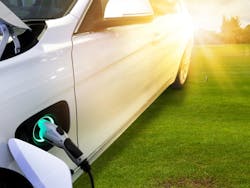Cars, homes and microgrids will be key market actors in a future where consumers produce and share energy. eMotorWerks and LO3 Energy intend to demonstrate that such a future is getting closer.
The two companies announced a collaboration today to test tools that will let consumers buy and sell electricity within microgrids using their homes and vehicles. The partners want to show the efficiency of an energy ecosystem where vehicles don’t just take, but also give back, and consumers control their energy supply.
The companies are vetting demonstration sites, and the first could be at the Brooklyn Microgrid, a community blockchain project by LO3.
If testing goes well, they hope to see the trading platform applied to other microgrids worldwide.
Let’s make a deal
The microgrid will integrate eMotorWerks JuiceNet electric vehicle charging platform into LO3’s transactive energy system, Exergy. Consumers will set the price of energy in a system that in many ways mimics wholesale power markets but on a smaller scale, putting households and car drivers in charge.
“This is where the industry’s headed…being able to leverage electric vehicle batteries and flexible resources locally,” said Vincent Schachter, senior vice president, energy services of eMotorWerks in an interview with Microgrid Knowledge.
What this means practically is that an electric vehicle driver could pull up to the microgrid, plug in, and manage its relationship with the energy sellers within — likely homes or buildings that use rooftop solar. The vehicle gets to leverage its battery; the households gain an additional energy resource to consider.
Who buys what will depend on circumstances, timing and price. Maybe it’s cloudy and homeowners in the microgrid are willing to buy energy from the vehicle. Or perhaps it’s sunny and the households are over-producing solar energy, so they offer the vehicle low-cost electrons for charging.
The buyers and sellers would agree upon price under certain parameters. For example, a household might offer to buy the energy if it falls to a given price. Or the electric vehicle owner might say: ‘Use my battery but be sure to recharge my car by 9 p.m.’
Of course, homeowners and car drivers are unlikely to actually talk (save for a few geeks) or make pricing offers themselves. An automated, algorithm-driven system does the work under conditions preset by the actors, something eMotorwerks already offers via its JuiceNet smartphone application.
The virtual battery
eMotorWerks, a division of Enel, made a splash in September with a 30-MW virtual battery, made up of 6,000 electric vehicle chargers, that it aggregates for participation in California’s wholesale power markets. The Brooklyn Microgrid could mark the next step in the company’s system evolution, as it demonstrates its platform operating on the microgrid level.
“It’s in our DNA to try to optimize the energy related to charging and then to deliver whichever services we can deliver in a given geography that make sense for our customers and partners,” Schachter said.
eMotorWerks and LO3 decided to work together after realizing that their products complement one another, according to Schachter.
In the microgrid, LO3 will provide the financial platform that manages the price signals and peer-to-peer transactions via a token system. It handles energy transactions within the microgrid and between the microgrid and the central grid. Using LO3’s mobile app, consumers decide what they’re willing to pay for local energy produced. The highest bidder wins.
eMotorWerks JuiceNet allows control over the flow of energy. It aggregates supply and demand and makes matches in real time using a cloud-based platform.
“We’ve been on that wave of aggregating demand response with EV batteries for the last couple years in California. But this is an evolution from the status quo — the ability to do it and then to trade,” Schachter said.
Courtesy of eMotorWerks
Enough power for all?
In addition to fostering local energy markets, the platform addresses one of the big worries about electric vehicles. Charging just one electric vehicle can be equivalent to adding two or three homes to an electric grid in some places, according to eMotorWerks. Can the grid provide all of the electricity that electric vehicles will demand?
Globally yes, but in specific congested locations, maybe not, Schachter said. Envision a neighborhood where everyone arrives home from work at roughly the same time and plugs in their cars for charging.
Under these circumstances, energy management becomes “all about space and time,” he said. It becomes important to monitor, track and control the movement of energy in a granular manner, something the trading platform can do.
The companies hope to show they’ve created what’s needed for a future where more homes and electric vehicles operate within energy communities like the Brooklyn Microgrid — something it’s clear government policymakers want to see, Schachter said.
Stay tuned. The partners expect to have a demonstration ready to show in under a year.
Track news about electric vehicles and microgrids. Subscribe to the free Microgrid Knowledge newsletter.
About the Author
Elisa Wood
Editor-in-Chief
Elisa Wood is the editor and founder of EnergyChangemakers.com. She is co-founder and former editor of Microgrid Knowledge.
